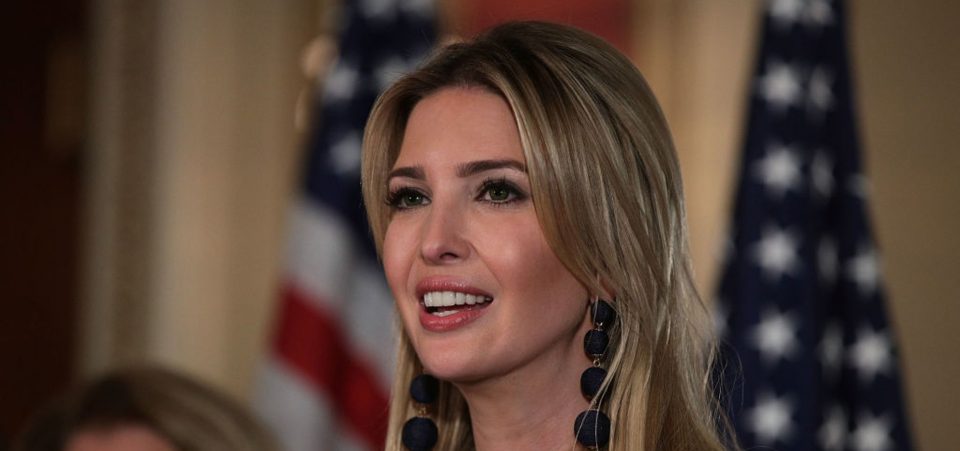Ivanka Trump Says the U.S. Spends Less Than Any Developed Country on Children: She’s Right
Ivanka Trump, the “first daughter,” offered some unusual observations for someone of her exalted station. Ivanka, who appears to hold considerable influence with her father, President Donald Trump, recently spoke to Fox News’s noted commentator, Tucker Carlson, about taxes. Specifically, she addressed tax reform. While urging that it be done quickly and properly, Ivanka Trump spoke of her father’s tax reform plan in terms most people would expect from Hillary Clinton than from any Trump family members.
Her father’s tax plan might target lowering taxes to offer incentives for businesses to grow, but Ivanka spoke in more “liberal” terms about taxes than Hillary Clinton. It was positively straight out of the Bernie Sanders playbook. The president’s daughter and trusted advisor claimed that the United States spends less than any developed country on children between zero and five years of age. Evidence suggests that the claim is correct. In fact, even if Ivanka’s more ambitious program were to pass, it still would not match the most generous industrialized countries’ childcare contributions.
That sounds odd. But it’s worth investigating. At first glance, compared to the wide-ranging social programs in many European countries, in Canada or Japan or even some developing countries, parents—often mothers—don’t get much in the way of government support to raise their pre-school-age children.
Many would say the same about U.S. spending on healthcare. American individuals pay far more for medical care—especially when they don’t have insurance—than many of their developing- and developed-country counterparts. But the U.S. government spends more taxpayer money on healthcare than most other countries.
All the Rich Countries Subsidize Children
Many developed countries offer tax advantages to parents. In France, there is free or highly affordable childcare for children, starting as early as nine months of age. There are rules and higher earners pay more, but by and large, it’s one of the best benefits for parents. Such a system allows both parents to keep working without having to worry about the huge burden of paying for daycare; something only the rich can truly afford in the United States.
Then there are more direct tax credits and tax deductions. The ones most similar in form—though more generous—are in Germany and the United Kingdom. But, OECD data from 2010 gives a direct indication of how little the United States spends on children compared to other countries. The following is based on normalized data based on 2007 U.S. dollars spent per year. Not surprisingly, the relatively rich and very small country of Luxembourg is the most generous contributor to parents:
| Country | Payments/child |
|---|---|
| Luxembourg | 3,846 |
| Australia | 3,613 |
| New Zealand | 3,133 |
| Iceland | 3,153 |
| Ireland | 2,628 |
| Germany | 2,530 |
| Denmark | 2,306 |
| Austria | 2,150 |
| Norway | 1,987 |
| Switzerland | 1,950 |
| Slovakia | 1,898 |
| U.K. | 1,883 |
| Sweden | 1,865 |
| Belgium | 1,739 |
| Finland | 1,643 |
| Italy | 1,495 |
| Netherlands | 1,488 |
| Canada | 1,194 |
| U.S.A. | 1,056 |
(Data Source: “Child benefit: how it compares across the world,” The Telegraph, October 4, 2010.)
The costs of getting even basic treatments in the United States are sometimes three, four, or even eight times as much as those of other advanced countries. In Switzerland, an MRI costs about $135.00 on average. In the U.S., that same procedure costs about $1,163. (Source: “Why our health care costs so much — and why fixes aren’t likely,” The San Diego Tribune, March 18, 2017.)
That alone, I suspect, would imply that the U.S. spends more on pre-school-age children than other countries because so many of the costs are health-related. But it spends its money badly on services that cost, even at the basic level, much more than they do in other countries.
The Basics: The U.S. Tax System Is Too Complicated
Any analysis of the current U.S. system from a general point of view cannot but start with how complicated it is. In this context, the new tax plan is supposed to be simpler. But Ivanka’s strategy to promote the tax plan to the American people was long and dense in describing its benefits for working families while short and curt on what it will do for big business and families such her own.
Mrs. Kushner, aka Ivanka Trump, extolled what she called the “dual focus” of the plan. The lower business taxes are intended to attract American businesses to repatriate facilities and profits stateside, thus generating more capital for investment and private-sector job creation. It would also create more incentives for the government sector to create jobs, thanks to overall higher returns (because of the repatriations).
But the core of Ivanka’s argument in favor of the tax plan was framed in the context of “women and the workplace.” This is one of her main causes. Ivanka told Carlson that she was concerned about the fact that there are so few women in the so-called category vaguely known as “jobs of the future.” She brought figures to back up her claims about the shortage of women in the tech workplace. Trump’s daughter underlined that women only make up 21% of the technology sector and 13% of engineers. (Source: “WATCH: Ivanka Trump Pushes ‘Critically Important’ Tax Reform Plan,” Fox News, November 6, 2017.)
The U.S. tax system might conservatively be described as a maze. Some would go further, calling it a mess. Trump’s electoral promises to reform the tax system may well have been one of the reasons so many voted for him. Yet, the reform might be too ambitious. The proposed reform will raise many challenges, not least of which is the problem that lowering taxes for every individual, corporation, and small business cannot be done without first finding substitute sources to cover the cuts. Trump has promised massive infrastructure investments, but how could these possibly get financed if the Federal government has fewer resources?
Trump and his fiscal advisors, including Secretary of the Treasury Steve Mnuchin have generally argued that simplifying the way taxes are collected alone could generate more tax revenue. Indeed, the tax collection system and the related software or forms are so complex that few people dare tackle the task alone. That leads perfectly normal and law-abiding citizens to delay filing their taxes out of sheer exasperation.
Alternatively, it forces many to seek the assistance of a tax advisor or special software. In other words, many Americans pay simply to complete the tax return, regardless of whether they owe more or whether they’re getting a refund. Naturally, individuals and small businesses feel this pain more than others. They can’t count on the accounting departments that any typical medium or large corporation might have. They have to do their taxes while worrying about making dinner, taking little Joey to basketball practice or helping Jack and Jill with their proverbial homework.
Still, for all the optimists who see Trump’s simplified fiscal plan as raising an additional $1.5 trillion in revenue over the next 10 years, there’s an equal number of pessimists who insist the plan makes too many cuts. They say it will raise the already teetering deficit by an equally flabbergasting amount.
Where Will We Find the Money?
On paper, it’s hard to argue with Trump. If Congress approves it, Americans could find it much easier to file in 2018. The new system cuts the number of income tax brackets from seven to a much more manageable three. Essentially, Americans could end up paying one of these three percentages in income taxes: 12%, 25% or 35%. To make this even more palatable, Trump has also included in the proposal sent before Congress to scrap the much-hated—by the richest, at any rate—inheritance tax, known officially as the Estate Tax. Unofficially, it goes by the more sinister name “Death Tax.” But this is hardly middle-class pleasing. It favors the very richest Americans, those who leave more than $5.0 million at least to their heirs.
Still, in this smorgasbord of fiscal easing, where would Ivanka Trump find the funds to improve the situation for parents and mothers in particular? Ivanka Trump’s tax credit for families to ease their financial burden in raising young children (zero to five years old) clearly needs more money—not less. Ivanka’s plan wants to raise the child tax credit, which now stands at $1,000 per child (to those Americans who qualify). Even this credit is rather new. With bipartisan support, it passed in 1997. (Source: “Ivanka Trump is spearheading an expansion of tax relief for parents, and the GOP is fighting her,” Business Insider, November 2, 2017.)
The Republicans have not supported Ivanka’s ambitious plans. The President’s daughter first advanced a tax credit program to benefit lower-income families. But she has changed her position, perhaps realizing that low-income people don’t need tax-deductible costs. They need more direct financial assistance. Tax deductions are the kinds of benefits that richer or higher middle-class Americans are after. For poorer Americans, tax deductions do little or nothing. They need more direct access to funds.
Still, the House, thanks to the efforts of Republican Senators Marco Rubio and Mike Lee, would agree to raise the current $1,000 child credit to $1,600. But Rubio and Ivanka want more. They see anything less than $2,000 as pointless. They also insist that families too poor to pay income taxes receive the $2,000 credit as a refund. There’s little to argue that these families would be the ones to benefit the most.
Ironically, the kind of child credit that Ivanka would like puts her at odds with her father’s fiscal reform. Critics of Trump’s plans, even as they might welcome the simplification in filing taxes, say the plan benefits rich families most. After all, a reduction in taxes for the richest Americans could imply millions—if not billions, in a few cases—of taxes pocketed. For lower-income Americans, even a 10%-20% reduction in their tax burden would still amount to small gains.
Some might point out that the current 35% corporate tax rate is among the highest in the industrialized world. But, companies often claim major deductions for their investment and such things as depreciation of equipment, for example. Regardless, the claim that the United States spends less than most developed countries on children between the ages of zero and five is generally correct.






